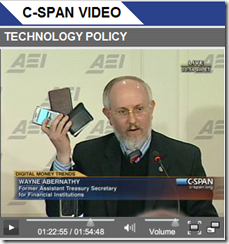Digital currency: trends, innovation and regulation
The shift from paper base to digital currency has been quietly transformative. A panel of financial experts discuss digital currency, trends, innovation and regulatory policies to consider and avoid.
To start, digital money trends show favorable growth. Between 2003 and 2008, card-based transactions grew by 13% worldwide. And government use is part of this growth. For example, the U.S. federal government is using purchasing cards for procurement to save $1.7 billion a year according to a GAO study. Beyond cards, consumers have embraced new technologies that facilitate convenient and secure electronic payments across a wide range of platforms.
While banks are regulated, what about a host of non-bank participants who provide alternative payment services from ecommerce, person-to-person, micro transactions or prepaid? Should they be regulated to address consumer protections, data security, money laundering, anti-terrorism and other illegal activity and if so, how?
Finding the right regulatory structures necessary to support continued payment innovation is important. As an example of what to do - emulate Check 21. Check 21 law was established in 2003 and went from zero to nearly 100% adoption in five years. This success is pointed to as a regulatory model to follow where the legal framework is established but no specific solution is mandated; where baseline consumer protection is set but not the process of exchange, letting the market freely adjust to changes in technology and innovation. The government’s role is to protect fair competition but must resist the urge to intervene with price controls. In Australia where regulators artificially suppressed Interchange pricing, consumers didn’t get lower cost or added benefits from retailers and incurred lower rewards and more fees when making certain payment choices.
All payment systems are measured by four factors: security, integrity, efficiency and reliability. With the growth in the variety of payment mechanisms, consumers making payment choices adjust market share to those payment systems who best meet this criteria. This free market approach is better than having politicians pick winners and losers. Regulations should provide the framework to impose security and protect integrity through standards but not set pricing or otherwise inhibit innovation.
Watch this C-Span video presentation of the American Enterprise Institute Discussion on Digital Money
